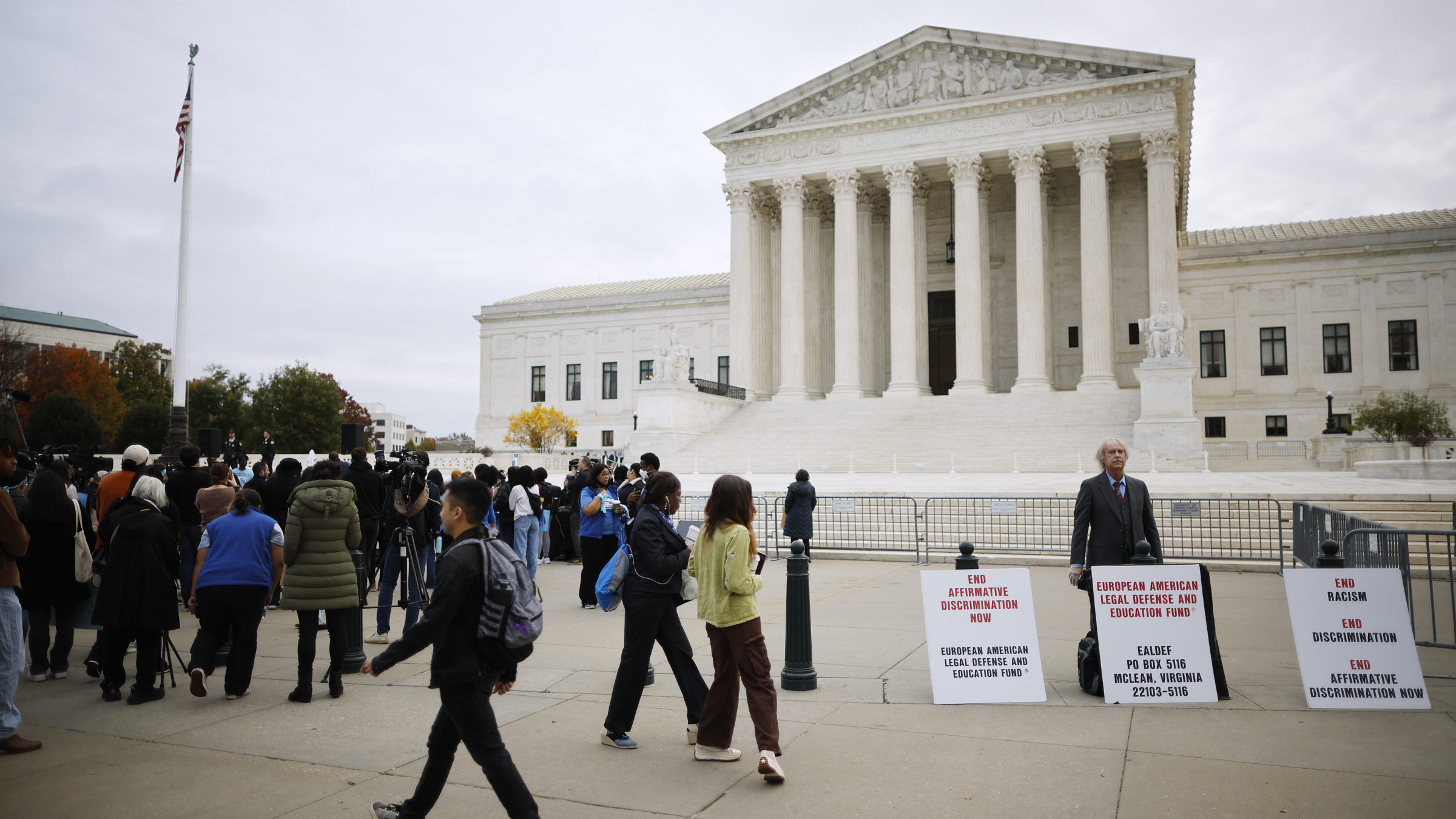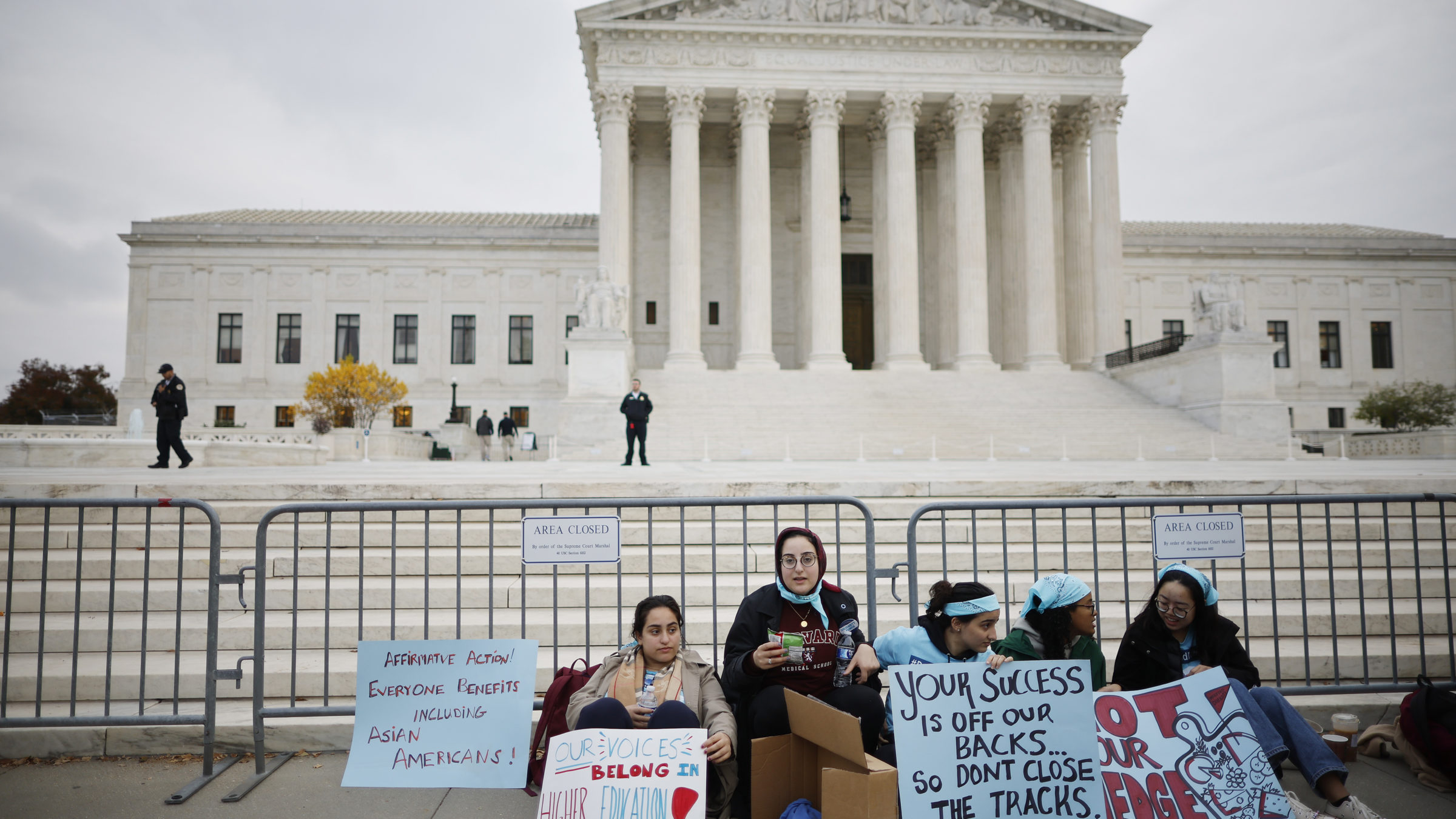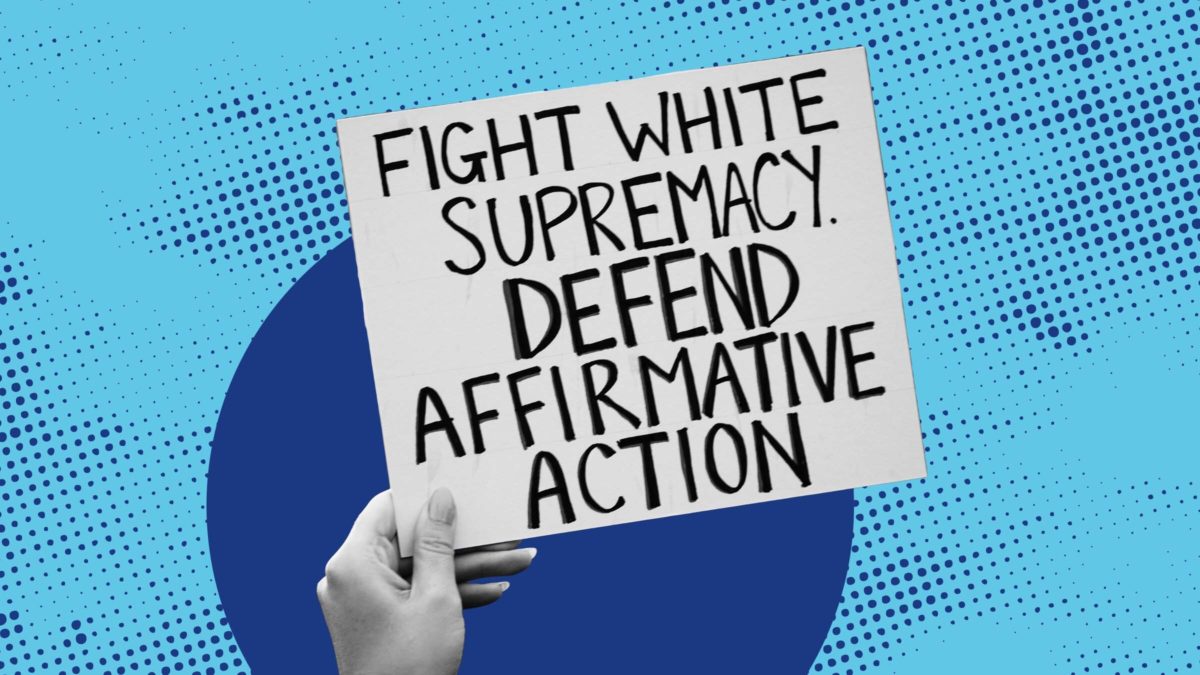How does a country founded on the enslavement of Black people move from a society organized around racial inequality to one in which that hierarchy no longer exists? This was the question that many racial justice advocates asked themselves in the wake of the Supreme Court’s 1954 decision in Brown v. Board of Education, which ordered the desegregation of public schools, and throughout the Civil Rights Movement that followed.
Since then, the Supreme Court has affirmed that the government can play some role in ensuring equitable access to public education. But in a series of cases brought by white challengers to affirmative action, the Court has steadily narrowed the circumstances under which the government—and especially public schools—can do so. Allan Bakke’s challenge to affirmative action at the U.C. Davis School of Medicine, for example, led to a prohibition on “racial quotas” in 1978. In 2003, Barbara Grutter’s challenge to admissions policies at the University of Michigan Law School allowed universities to consider applicants’ race for the purposes of obtaining a “critical mass” of people of color. But in 25 years, wrote Justice Sandra Day O’Connor, the Court expected that “the use of racial preferences will no longer be necessary.”
On Monday, the Court revisited the issue slightly ahead of schedule when it heard oral arguments in Students for Fair Admissions v. University of North Carolina and Students for Fair Admissions v. President & Fellows of Harvard College. In these cases, the justices will once again consider whether the Constitution allows public universities to consider race among many other factors when making admissions decisions—and, in a related case about Harvard’s admissions process, whether federal civil rights law allows private universities to do the same. Soon, a legal system that has failed since its inception to address this country’s legacy of racism might forbid universities from even trying.
Like O’Connor, proponents of early affirmative action programs aspired to a colorblind future. When President John F. Kennedy, for example, signed the executive order from which affirmative action gained its moniker, he instructed federal contractors to take “affirmative action to ensure that applicants are treated equally without regard to race, color, religion, sex, or national origin.”
Patrick Strawbridge, a lawyer representing Students for Fair Admissions, reiterated the framing at oral argument to bolster support for his position that universities cannot use race at all in admissions. Allowing universities to do so, he told the justices, “gets us further away from a world where the government treats race as irrelevant.”

An anti-affirmative action protester stands outside the Supreme Court building on Monday (Photo by Chip Somodevilla/Getty Images)
But Gary Peller, professor at Georgetown University Law Center, argues that this framing of affirmative action, though well-intentioned, created space for the very challenge that Students for Fair Admissions is putting forward. According to him, white liberals of the 1960s believed that ending state-ordered segregation would inevitably lead to racial integration. This focus on the state’s formal role in upholding white supremacy obscured how racial inequality also permeates social and cultural metrics of “merit,” like standardized test results, grades, and counselor or teacher recommendation letters.
As a result, Peller argues, the movement to end apartheid in the United States—what he calls “integrationism”—ended up reinforcing pre-existing racial inequities in the education system instead of challenging them. Last month, we spoke with Peller to learn more about how this framing weakened the case for meaningful intervention—and how progressives can move forward when the Court shuts the door on affirmative action for good. The conversation has been edited and condensed for clarity.
Balls & Strikes: You’ve argued that, at one point, racial integration represented a powerful social movement that threatened to upend hierarchies within the US. And then it became this watered-down vision of racial justice. How did that switch happen?
Gary Peller: Dr. Martin Luther King led a movement with a prophetic voice that had a moral dimension. Dr. King inspired hundreds of thousands, maybe millions, of ordinary citizens to resist Jim Crow segregation. Even the simple act of house cleaners leaving the house and going and marching with King for an afternoon was a major act of defiance. It was a deep, existential, in-your-face disruption of business as usual. At that point, integration meant resisting the apartheid system in America.
What happened is that this popular integrationist movement formed a natural alliance with a slightly different kind of ideology— a more legalistic ideology that saw race discrimination as an exception to thinking clearly and in enlightened ways about giving people jobs and positions in educational institutions based on their merit.
What emerged by the mid-to-late 1960s was a coalition of well-meaning white liberals and progressives who understood racial justice in terms of a very limited view that I’ve come to call “integrationist.” What this ideology did was locate the social power of racism in people’s consciousness. The social face of this consciousness could be job discrimination, for example, and the solution would be equal treatment—meritocracy. Similarly, integrationists believe the solution to prejudice is colorblindness—not thinking about people in terms of color, because color is just skin-deep.
Relevant to the affirmative action debate is that white progressives in positions of power at universities wanted to integrate their institutions, but applying their own terms of “meritocracy,” these administrators basically couldn’t play. So, they adopted affirmative action. But their defensive justification for affirmative action is arguably humiliating and grotesque, like, “Well, we’re only going to need to do this for a short time until a new generation that’s not scarred by the history of subordination comes along.” Or, more often, “These people come from disadvantaged backgrounds, so in order to compete with more privileged people, we need to put a thumb on the scale for them.”
The deep assumption is that everybody is being evaluated according to race-neutral norms. The insidious message of this form of integrationism is the embrace of “meritocracy.”

Supporters of affirmative action gather outside the Supreme Court building (Photo by Chip Somodevilla/Getty Images)
What does the integrationist ideology assume about the existing criteria for admissions and employment?
It insists, falsely, that there is some neutral, objective way to determine qualifications to attend a law school or to even be a lawyer. It tells the beneficiaries of affirmative action: “You’re not qualified under the normal stuff. We’re going to help you out because of your background.” Or the other one: “You’re going to add to the diversity here, mix it up. We’d like our white students to have some contact with other people.”
Integrationist ideology in this way becomes the exact opposite of what I described of Dr. King. It becomes a legitimation of social hierarchy by claiming that social hierarchy is a product of meritocracy.
How do Brown v. Board and its various justifications relate to integrationism?
The Supreme Court said “separate is inherently unequal,” and that sounds like colorblindness—like even just thinking about race has got to be only in the context of wanting to subordinate. That’s the root, actually, of the whole affirmative action problem: the assumption that thinking about race is itself a problem. That stands in contrast to acknowledging that race consciousness is the normal, natural way to perceive our social reality.
What is embraced by conservatives today is the colorblind misinterpretation. Conservatives also claim that colorblindness is what Dr. King stood for. But there’s another interpretation of Brown that shows at least a nod to what I was saying—that racism doesn’t exist just in people’s heads. It’s out in the world and history.
Integrationism went from being a white liberal approach to later being adopted by conservatives like Chief Justice John Roberts and Justices Clarence Thomas and Sandra Day O’Connor. They all espoused this idea of a colorblind Equal Protection Clause that strikes down any policy that thinks about race, which is how we are here today with the affirmative action challenge. How did that happen?
There’s a very particular moment that I remember. It was in a Southern Christian Leadership Conference March in the South in which one of the marchers started chanting “Black Power, Black Power!” It was 1967 or 1968. Immediately, that chant was denounced by a broad spectrum of the “enlightened” progressive coalition behind civil rights in the United States, who called it “racist.”
I would say that the roots of this shift were planted right there in that denunciation of race consciousness. Instead of any openness about how this was offered by Black nationalists as an alternative way to think about racial justice, it was simply denounced as another form of racism.
I think the rhetoric of supporting affirmative action essentially shows that, at least in the white community, the vision of racial justice as colorblindness persists, and they just make an exception for affirmative action. They aren’t talking about equitably dividing social power amongst communities.
Some of the Supreme Court cases come close to that. In Grutter, the justices talk about the need for a “critical mass” of students—of people who would become leaders in their communities. There seemed to be a bit of recognition that the Black community itself, for example, might have community interests worth considering in the affirmative action debate.
Are there other ways that integrationist ideology shows up in judicial opinions today?
Integrationism is part of the dominant ideology of American liberal legal constitutionalism. A central part of integrationism is the embrace of the idea that there could be neutral, objective ways to divvy up social benefits, like jobs or admission to law schools and colleges.
And so the quick answer is yes; it’s basically everywhere. Integrationism is the racial front of a broader ideology of legitimating social hierarchies in the United States—of the legitimating ideas that some people are better than others and deserve more.
What does the alternative look like?
I think integrated or cosmopolitan institutions should exist side by side with institutions envisioned by the Black nationalist movement and people like Malcolm X. Malcolm X made the argument that it’s not the segregation or separation of white kids and Black kids that’s the problem. It’s the colonial relationship with a white community that is the problem. He said “Give us money to run our own schools. Let us hire our own teachers. Let us buy our own books. We will teach our kids.” And that’s a deeply inspiring message, particularly when those very kids are being told by the pre-existing system that they’re not as smart.

